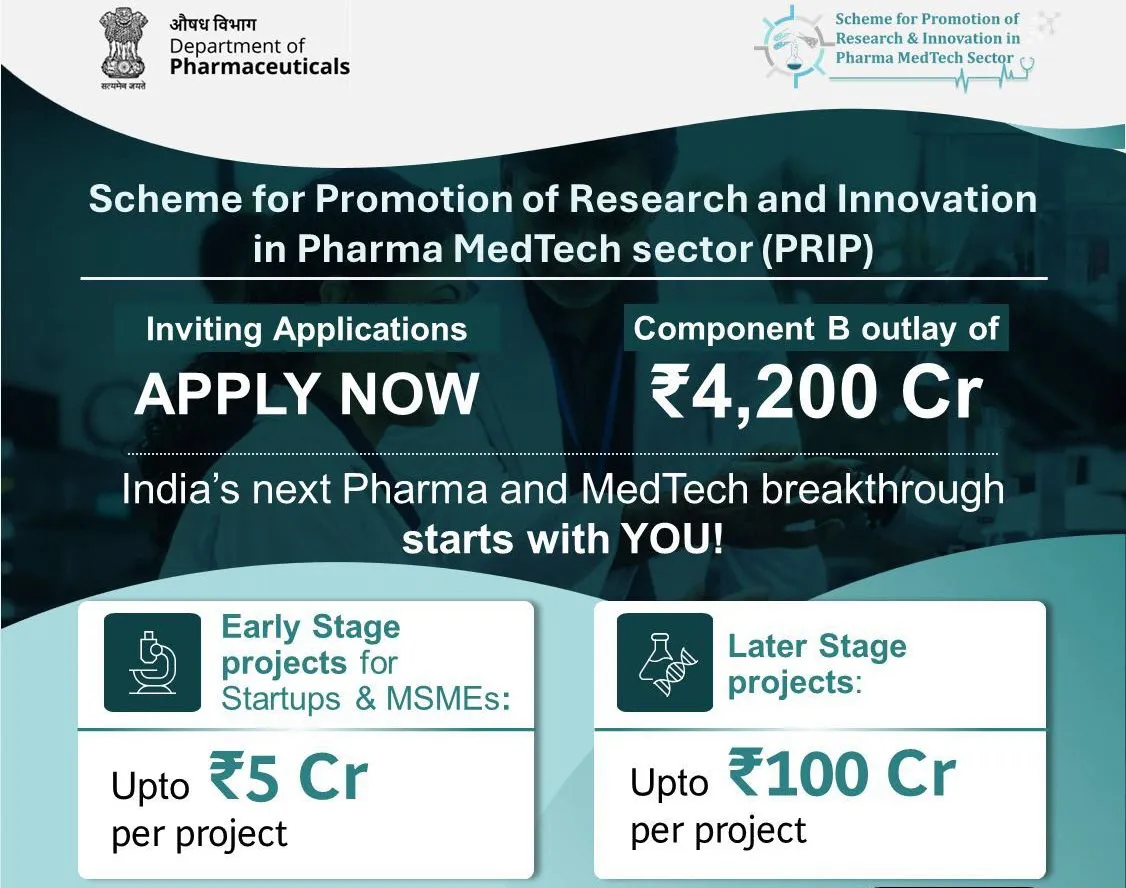Introduction
Pharmaceutical sector requires continued research to remain competitive. However, to leapfrog substantive measures are needed to venture into new areas to garner more value to the product and achieve increased exports. Expansion of the industry’s presence in the innovation accounts for 2/3rd of the global pharmaceuticals opportunities.
Objectives
The objective of the scheme is to transform Indian Pharma MedTech sector from cost based to innovation-based growth by strengthening the research infrastructure in the country. The aim of the scheme is to promote industry-academia linkage for R&D in priority areas and to inculcate the culture of quality research and nurture our pool of scientists. This will lead to sustained global competitive advantage and contribute to quality employment generation in the country.
Salient features of the Scheme :
The scheme is proposed to have two components as follows-
Component A : Strengthening the research Infrastructure – Setting up of Centres of Excellence at National Institute of Pharmaceutical Education & Research (NIPERs): Department has set up seven National Institutes of Pharmaceutical Education & Research (NIPERs) as institutes of national importance for imparting postgraduate and doctorate education and conduct high end research in various specializations in pharmaceutics. NIPERs have increasingly started giving higher importance to research, which is evident from deciding on a ‘Common Research Programme’ (CRP), launch of NIPER Research Portal and enhanced importance to industry academia linkage. Subsequently, on amendment of NIPER Act in December 2021, a provision ‘to establish Centres of Excellence for drug discovery and development and medical devices’ has been specifically included as one of the functions of these Institutes. Recently, in the Budget speech 2023-24, it has specifically been announced that ‘Para 30: A new Programme to promote research and innovation in pharmaceuticals will be taken up through centres of excellence. We shall also encourage industry to invest in research and development in specific priority areas.’ It is, therefore, proposed to establish CoEs in the seven existing NIPERs at Mohali, Ahmedabad, Hyderabad, Guwahati, Kolkata, Hajipur and Raebareli at a tentative cost of Rs. 700 cr over a period of five years in following specializations: (i) NIPER Mohali- Anti-Viral and Anti- Bacterial Drug Discovery and Development (ii) NIPER Ahmedabad- Medical Devices (iii) NIPER Hyderabad- Bulk Drugs (iv) NIPER Kolkata- Flow Chemistry and Continuous Manufacturing (v) NIPER Raebareli- Novel Drug Delivery System (vi) NIPER Guwahati- Phyto-pharmaceuticals (vii) NIPER Hajipur- Biological Therapeutics This will help in building specific research capacities in the identified priority areas in a focused time bound programme, tapping industry-academia linkage. The CoEs will strengthen the research infrastructure in Pharma-MedTech sectors in the country by providing advanced facilities to conduct research and will also help in nurturing talent pool by promoting industry academia linkage.
Component B – Promotion of Research and Innovation in Pharma MedTech sector
3.2.1 Financial assistance to industry and startups: With a view to enable Indian Pharmaceutical and MedTech industry and startups to leapfrog up the innovation value chain, financial assistance will be provided under Component B to support, in the priority areas specified in paragraph 5 (“priority areas”), research and development (“R&D”) for development of products and technologies (“outputs”) or expeditious validation of R&D outputs for market launch and large-scale commercialisation or both. Both Early Stage Projects and Later Stage Projects will be eligible for disbursement of financial assistance.
3.2.2 Collaboration with academia: With a view to build world-class research infrastructure and atmosphere and deepen the talent pool of qualified, trained students, for both Early Stage Projects and Later Stage Projects, industry and startups will be encouraged to collaborate flexibly with reputed Government academic and research institutions specified in the Scheme guidelines (“Academia”) to develop, translate and commercialise institutional intellectual property and to augment institutional research capacities in India. While assessing applications under paragraph
3.2.3 in response to the call for proposals, a total of nine applications each for projects in collaboration with Government institutions of national repute will be given preference in selection from among (a) Early Stage Projects as referred to in paragraph
3.2.4 and (b) Later Stage Projects as referred to in paragraph
3.2.5. Selection based on such preference will be subject to (i) the project being assessed as involving significant collaborative development of product/technology and strong credentials of collaborative partners/team and (ii) the availability of applications that meet the aforesaid criteria, failing which other projects may be selected. Collaboration with Academia may include, among other things, in-licensing of intellectual property (IP) from or usage of assets made available by Academia as well as the use of both existing and any freshly created research infrastructure facilities, provided that the cost of in-licensing in the approved project cost is restricted to third-party-assessed fair value of in-licensed IP and the applicant ensures that the terms of such collaboration are duly documented and not in conflict with its obligations under the Scheme. Further, in case of in- licensing, such documentation will be in the form of a valid contract that sets out the terms of licensing, including (i) appropriate usage rights for future commercialisation of outputs and (ii) the treatment of any further IP that may be developed using such IP.
3.2.3 Other support: With a view to enhance the prospects of commercialisation of viable outputs, industry and startups may also take advantage of mentorship support that may be provided under the Scheme, relevant government initiatives such as MedTech Mitra and Patent Mitra, and the online platform under the Scheme to facilitate discovery of opportunities for collaboration and partnership among various stakeholders, such as industry, startups, Academia, investors, incubators, accelerators, innovation-promoting agencies and non- governmental organisations. 3.2.4 Eligibility and scale of assistance for Early Stage Projects: The eligibility and extent of financial assistance in respect of Early Stage Projects are as follows: (a) Eligibility in terms of Technology Readiness Levels (TRLs): Projects of startups and MSMEs to take products or technologies at TRL 1, 2 or 3 in any priority area to higher TRLs not beyond TRL 5 will be eligible. (b) Scale of assistance: Financial assistance may be to the extent of Rs.5 crore per project. In case the approved total project cost is up to Rs. 1 crore, no co-funding from the applicant will be required. In case it exceeds Rs. 1 crore, half of the project cost exceeding Rs. 1 crore will be co-funded by the applicant. 3.2.5 Eligibility and scale of assistance for Later Stage Projects: The eligibility and extent of financial assistance in respect of Later Stage Projects are as follows: (a) Eligibility in terms of TRLs: Projects of industry and startups to take products or technologies at TRL 4, 5, or 6 in any priority area to higher TRLs will be eligible.
(b) Scale of assistance: (i) Financial assistance may be to the extent of Rs. 100 crore per project, subject to the condition that such assistance will be restricted to a maximum of 35% of the approved total project cost and the remainder of the approved total project cost will be co-funded by the applicant. (ii) Strategic Priority Innovations: For projects that promote innovative products and technologies that address areas of India’s public health concern for which market potential is relatively lower (“Strategic Priority Innovations” or “SPIs”), financial assistance may be to the extent of 50% of the approved total project cost. Cumulative assistance to the said extent, approved for such projects, will be capped at 20% of the total financial outlay for Component B. Such areas will be specified in the Scheme guidelines, in accordance with policy directions of the Empowered Committee.
3.2.6 Co-funding may include funds contributed by the applicant or mobilised from promoters, investors, other government organisations, non-governmental organisations or any other person.
3.2.7 Other terms and conditions : For both Early Stage Projects and Later Stage Projects, the following are other applicable terms and conditions:
(a) The eligibility to receive financial assistance is limited to the period of the Scheme.
(b) On successful achievement of approved timebound milestones, the Central Government, including its nominated agency (in this Scheme collectively referred to as “Central Government”), may, at its discretion and on the request of the beneficiary, provide additional or follow-on financial assistance on terms mutually agreed upon.
(c) Beneficiaries of the Scheme will ensure that assistance received under the Scheme is publicly acknowledged while publishing the findings related to R&D outputs.
(d) Other terms and conditions specified in the Scheme, and the terms and conditions contained in the Scheme guidelines and the funding and share allotment agreements under the Scheme will apply.
3.2.8 Selection of projects: Selection of projects under both categories will be done based on an assessment of such factors as the Central Government may consider relevant, which may include, among other things, the following:
(a) Impact on addressing India’s public health priorities;
(b) Novelty and technical rigour and soundness of the proposed product or technology;
(c) Soundness of the funding and expenditure plan;
(d) Strong credentials, including credibility and track record, of the project team and the applicant and any Academia partner for significant collaborative development; and
(e) Market potential and scalability of the proposed product or technology.
3.2.9 Such impact on addressing India’s public health priorities may, among other things, include significant public health gains that may arise from useful data that may become available for use in further R&D and AI-enablement, such as through the following:
(a) Voluntary commitments made in the application to make available pre-clinical and clinical research data generated under the project as a public good; and (b) Systematic, at-scale, privacy-preserving digital data capture by a medical device, by design.
Terms of financial assistance under Component B
4.1 Benefit-share
4.1.1 The Central Government will have the right to receive from every applicant to whom it has disbursed financial assistance, including such assigns of such applicant as the Central Government may permit and its successors-in-interest (such applicant, assigns and successors- in-interest are collectively referred to in the Scheme as “beneficiary”), such share as is specified in paragraphs
4.2 or 4.3 (“benefit-share”) in any commercial realisation arising directly or indirectly from the approved project. The right to receive the benefit-share will be irrespective of the manner of such realisation, which may include direct sale, licensing, assignment, transfer or any other act through which commercial value is realised from the whole or any part of any output developed from any activity carried out under an approved project, including from any further development using such output irrespective of whether such further development is done during the period of the project or subsequently. Every output developed as aforesaid is referred to in this Scheme as “project output”, and every project output from which commercial value is realised as aforesaid, is referred to in this Scheme as “commercialised output”.
4.1.2 The right to receive benefit-share will arise on the first commercial realisation from any commercialised output.
4.2 Benefit-share structure for Early Stage Projects
4.2.1 Every beneficiary to whom financial assistance is disbursed for an Early Stage Project will, prior to execution of the funding agreement for such project, select one of the following options for benefit-share, which will be specified under the funding agreement: (a) Fixed rate payout: Benefit-share is 5% of the net sales from each commercialised output, per year, starting from the first year of commercialisation. The benefit-share obligation will stand discharged once the total payments made by the beneficiary equal the total financial assistance disbursed. (b) Tiered rate payout: Benefit-share is (i) 2% of the net sales per year from the first year of commercialisation till the third year, (ii) 4% of net sales per year from the fourth year till the sixth year, and (iii) 6% of net sales per year from the seventh year onwards, for each commercialised output. The benefit-share obligation will stand discharged when the payments made by the beneficiary equal the total financial assistance disbursed. (c) Share allotment: Benefit-share is by way of allotment of shares to the Central Government of aggregate value equal to the total financial assistance disbursed, reckoned on fair value assessment basis in accordance with the manner specified under the Scheme guidelines and further detailed in a share allotment agreement to be entered into between the Central Government and the beneficiary prior to the first disbursement. Such beneficiaries will also secure liquidity and minority protection rights of the Central Government as further detailed under the said guidelines.
4.3 Benefit-share structure for Later Stage Projects
4.3.1 Every beneficiary to whom financial assistance is disbursed for a Later Stage Project will, at the time of execution of the funding agreement, elect one of the following benefit- shares, which will be specified under the funding agreement: (a) Fixed rate payout: Benefit-share is 10% of the net sales from each commercialised output, starting from the first year of commercialisation. The benefit-share obligation will stand discharged once the total payments made by the beneficiary equal 150% of the total financial assistance disbursed. (b) Tiered rate payout: Benefit-share is (i) 4% of net sales per year from the first year of sale to the end of the third year, (ii) 8% of net sales per year from the fourth year till the sixth year, and (iii) 12% of net sales per year from the seventh year onwards, for each commercialised output. The benefit-share obligation will stand discharged when the payments made by the beneficiary equal 150% of the total financial assistance disbursed. (c) Share allotment: Benefit-share is by way of allotment of shares to the Central Government of aggregate value equal to 100% of the total financial assistance disbursed, reckoned on fair value assessment basis in accordance with the manner specified under the Scheme guidelines and further detailed in a share allotment agreement to be entered into between the Central Government and the beneficiary prior to the first disbursement. Such beneficiaries will also secure liquidity and minority protection rights of the Central Government as further detailed under the Scheme guidelines.
4.4 Benefit-share computation for projects involving collaboration with Academia
4.4.1 For projects involving collaboration with the Academia, in case capital assets are transferred by the beneficiary to the books of the Academia for their use without consideration and are certified by such Academia as constituting public assets usable for R&D, for purposes of computation of benefit-share, the independently assessed fair value of such assets will be netted out from the total financial assistance disbursed. All references in the Scheme to “total financial assistance disbursed”, in relation to benefit-share, will be construed accordingly.
4.5 Settlement, termination and clawback
4.5.1 The Central Government may, on the request of the beneficiary, allow discharge of benefit-share obligation on one-time basis, on the terms and conditions specified in the Scheme guidelines and in the manner specified therein. 4.5.2 The Central Government will, on occurrence of any event specified in the Scheme guidelines and in the manner specified therein, have the right to require one-time settlement of its right to receive benefit-share. 4.5.3 The Central Government may, on occurrence of any event specified in the Scheme guidelines and in the manner specified therein, terminate an approved project, which will have the consequence of cessation of disbursement of financial assistance, refund of unutilised balance of the financial assistance previously disbursed along with interest accrued thereon and the requirement that the beneficiary furnish certain reports, statements etc., as detailed in the guidelines. 4.5.4 Notwithstanding anything contained in the Scheme, the Central Government may, on occurrence of any event specified in the Scheme guidelines and in the manner specified therein, terminate an approved project and exercise its right to clawback. 4.5.5 The Empowered Committee will be authorised to give policy directions in respect of matters to be specified in the Scheme guidelines under paragraph 4.5.
Financial outlay
6.1 The Scheme has a financial outlay of Rs. 5,000 crore, over the period from the financial year 2023-24 to the financial year 2029-30, as under :
1. Component A : 700
2. Component B : 4,200
3. Administrative cost : 100
6.2 The outlay for administrative cost will cover all costs other than the financial assistance under Components A and B, including the cost of other support referred to in paragraph 3.2.3 and that incurred on governance and implementation mechanisms and measures referred to in paragraph 7.
6.3 The Central Government may extend the period of the Scheme.
Impact of the Scheme
(a) Focus on certain priority areas which will help India’s pharma industry leapfrog and radically strengthen its position in the world market as innovation accounts for 2/3rd of global pharmaceutical opportunities
(b) Development of Research Infrastructure- The scheme would help in building world class research atmosphere at NIPERs by establishing CoE and making a talent pool of qualified trained students.
(c) The scheme would help in launching of commercially viable products thereby accelerating the growth of Indian Pharmaceuticals sector.
Deadline to Register on PRIP Portal : 3rd November 2025, 11:59 PM
Deadline for Application Submission on PRIP Portal : 10th November 2025, 11:59 PM
See All M.Pharm Alerts B.Pharm Alerts B.Sc Alerts Bihar Alerts
See All Other Jobs in our Database
Subscribe to Pharmatutor Job Alerts by Email









